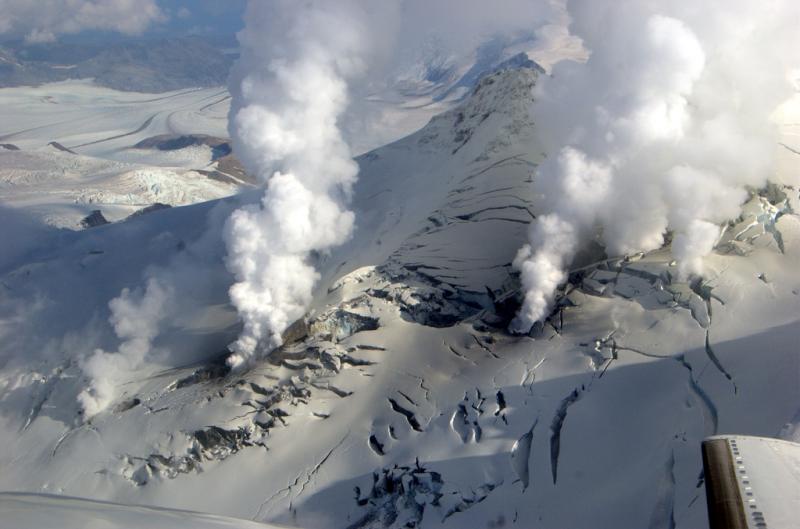Research in this theme explores the fascinating interactions between volcanoes and glaciers. This is of direct societal relevance, given that ~20% of all volcanoes in the world are ice-clad, and these are among the most dangerous, with eruption-related melt causing lahars, jökulhlaups, mud and debris flows. Identifying activity in advance of an eruptions, is not just an academic pursuit, but has real-world life and death implications. In this theme we explore how glaciers that sit on volcanoes could help act as a precursor of volcano awakening.

Image: Fumaroles on the west side of Fourpeak Volcano. Photo by Cyrus Read, courtesy of AVO/USGS
Volcanic eruptions can destroy infrastructure, displace communities, disrupt air travel, damage businesses and, unfortunately too often, take people's lives. Volcanoes sometimes show signs of increased thermal unrest for years prior to an eruption. These anomalies can be detected from satellite borne infrared sensors, but one of the issues with remote sensing based monitoring of volcanoes, is the presence of glaciers, which can mask or distort the thermal signal. This is of particular relevance, given that ice-clad volcanoes can lead to some of the most dangerous eruptions (e.g. triggering of lahars). It is precisely these volcanoes that our research group is targeting, through the development of an international, and truly multidisciplinary collaboration between UK glaciologists, and US and Italian volcanologists. For this theme we are using glaciers located on volcanoes as “thermometers", which could therefore be utilised to improve the monitoring of dangerous, ice-clad volcanoes. Our preliminary work in South America, now in the process of being extended worldwide, indicates that the calculated equilibrium line altitude (cELA) of glaciers that sit on volcanoes (volcanic-glaciers from now on) is considerably higher than for nearby "normal" glaciers. This suggests that volcanic-glaciers are impacted by enhanced basal melting, due to elevated geothermal heat flux from the underlying volcano, such that their dimensions and elevation are restricted. The "hotter" the volcano, the higher the cELA of volcanic-glaciers. Other research involves understanding and monitoring changes on the surface of volcanic glaciers (e.g. cauldron formation) that might also provide evidence of imminent volcanic unrest.
Besides the academic staff of the Cryosphere and Climate Change group in Aberdeen and collaborators at Manchester Metropolitan University, Turin, Fairbanks, Columbia and Meinz universities, this theme also involves a NERC funded PhD student in Aberdeen, a Leverhulme funded PhD student and a post doc based in Manchester and co-supervised by staff in Aberdeen, and a graduate research fellow sponsored by a NERC Seedcorn Fund.
